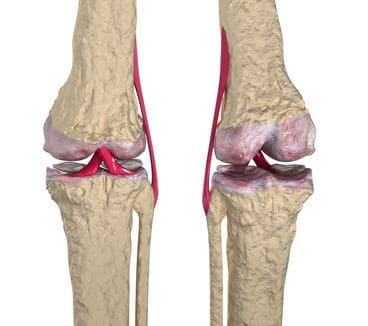

According to the National Library of Medicine, arthritis is the inflammation of one or more joints, involving the breakdown of cartilage, which normally helps to cushion joints and assists in the smooth movement of the joint in its range of motion. Arthritis can be caused by an autoimmune disease, a broken bone, wear and tear, or even a viral or bacterial infection. The results of arthritis are quite painful and include joint pain and swelling, reduced mobility and inflammation, which includes painful heat and redness at the joints affected.
While there are over 100 types of arthritis, three major types of arthritis are psoriatic arthritis, osteoarthritis and rheumatoid arthritis.
- Psoriatic arthritis is a result of complications of the skin condition psoriasis, where skin cells multiply up to ten times faster than normal, causing raised, red plaques covered with silver-white scales and itching. This form of arthritis results in pain and swelling in the affected joints.
- Osteoarthritis is a degenerative condition, often resulting from the wear and tear being overweight causes on joints. Osteoarthritis results in pain, swelling and decreased range of motion as the cartilage cushioning wears out and bones grind against each other.
- Finally, rheumatoid arthritis is an autoimmune disorder that typically affects the smaller joints of hands and feet by attaching the lining of the joints.
The Arthritis Foundation makes several suggestions to reduce pain from any form of arthritis:
- Maintain correct posture, both when sitting and standing, as slouching and hunching over can increase pressure on joints.
- Exercise – but do not go overboard. Moderate exercise has been shown to decrease the pain of arthritis.
- Lose weight; even a loss of 10 pounds can reduce pressure on knees by up to 60 pounds of pressure.
- Beyond helping to maintaining a healthy weight, McDougall, et. al. (2002) show that a very low fat, vegan diet has been shown to decrease pain from rheumatoid arthritis, improve function, and decrease joint tenderness and swelling as well as the severity of morning stiffness.
- Alternative therapies such as acupuncture and massage therapy have been shown to help reduce pain from arthritis.
- Run hot and cold: use heat to reduce chronic pain, but use ice to reduce the pain of acute inflammation and flare ups.
- Glucosamine and chondroitin sulfate supplementation have been shown to reduce joint damage, reducing long term increases in pain.
- Wear good shoes. Wearing shoes that do not offer proper support can lead to an increase in arthritis pain.
- If the pain is severe, speak to your doctor about steroid injections – steroids, or corticosteroids, such as cortisone, hydrocortisone and prednisone, are synthetic versions of the hormone cortisol which reduces inflammation.
- Transcutaneous electrical nerve stimulation (TENS): TENS involves hooking up to a pocket-sized, portable machine that sends electrical current to the painful spots, via wires attached to electrodes placed on the skin. A TENS unit can reduce pain in the long term but you may need to ask your doctor for assistance in setting this up.
Massage Therapy and Arthritis
Massage therapy has been used to reduce pain in several medical conditions, and has now been shown to do so for arthritis patients. Perlman, et. al. (2006) show us that massage therapy reduced pain and stiffness and increased physical function and range of motion in a study on the effects of massage on osteoarthritis of the knee. In another study on hand arthritis pain, Field, et. al. (2006) conducted a study which demonstrated that the massage therapy group had lower anxiety and depressed mood after the last massage treatment, along with less pain and greater grip strength after their sessions.
While massage therapy has been shown to improve the symptoms of arthritis overall and reduce the pain in the long term, massage should never be given when an individual is in an accute stage of arthritic flare up. When the joints are red, warm to the touch and swollen, massage therapy can actually exacerbate the problem, resulting in more intense flare ups and pain.
Glucosamine and Chondroitin Sulfate
There have been several studies showing positive results from taking glucosamine and chondroitin sulfate. A 2001 study by Reginster, et. al. on the long term effects of glucosamine on osteoarthritis showed that the placebo group had a progressive joint space loss after three years while the patients taking glucosamine had minimal joint space narrowing and even showed improvement after treatment. Similarly, a 2000 meta-analysis of glucosamine and chondroitin for treatment of osteoarthritis concluded that, while the results may be more modest than the original published trials claim, these substances offer a safe treatment which offers results. Many also find that taking joint support supplements offers relief from the pain of arthritis flare ups and painful inflammation.











